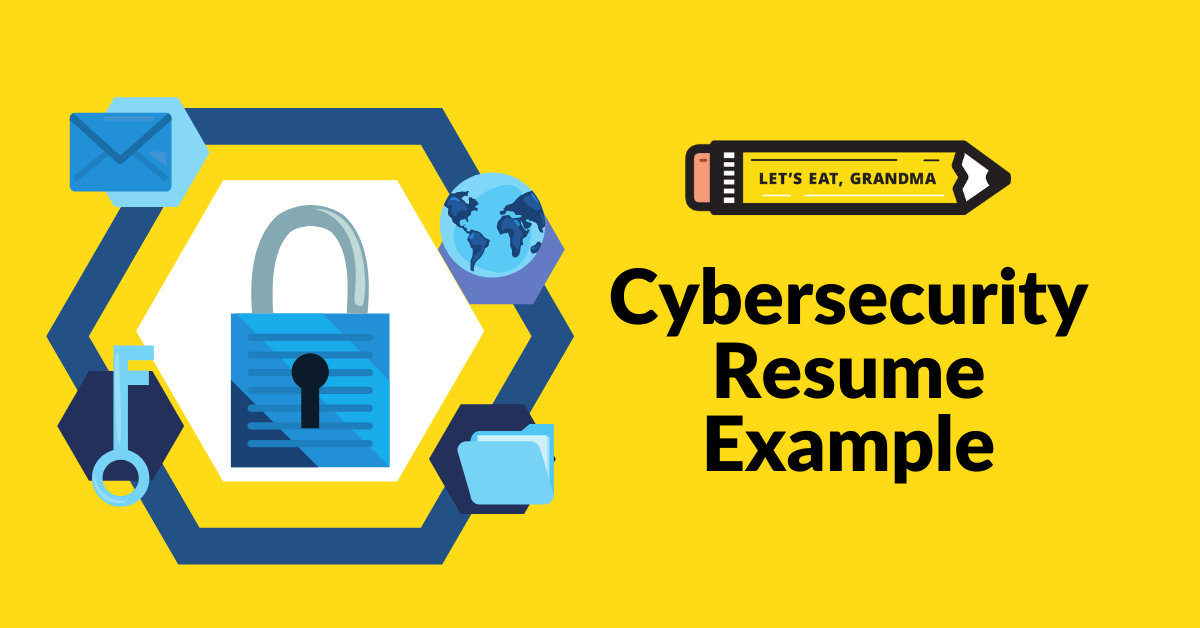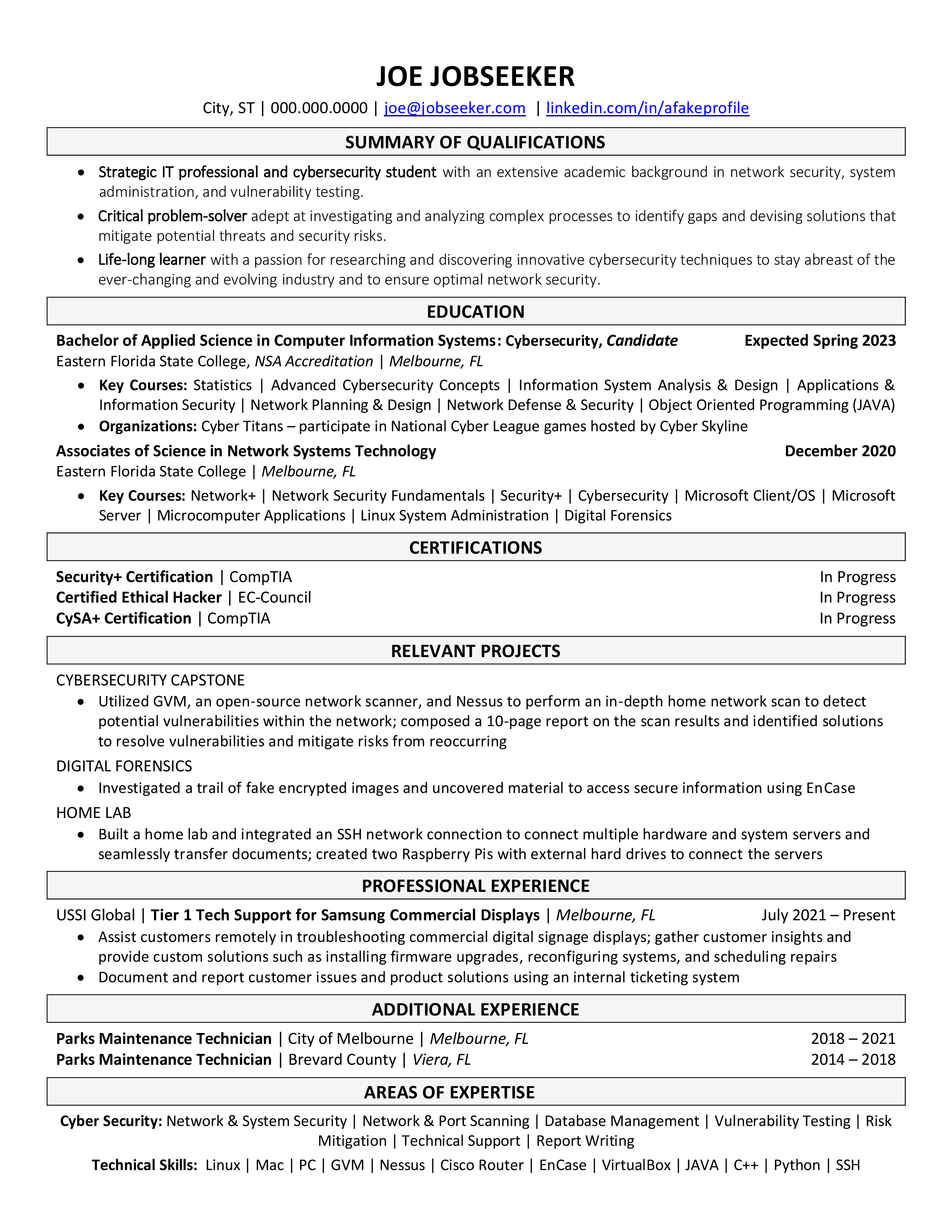Cybersecurity Resume Example: Learn What Makes it Great

By: Tonyia Cone | Contributor for Let’s Eat, Grandma
Cybersecurity professionals are in high demand and with cyber crimes on the rise, the field is projected to continue its rapid growth. If you are job hunting in this area, you’re in luck. Many cybersecurity positions are unfilled, so your first step in claiming a piece of this highly paid pie is to turn your attention to your resume.
Ready for more job search help?
Sign up for a free Senior Writer Resume Critique to see what's holding you back from landing interviews. One of our top professional resume writers will give you personalized feedback on the top 3 items you can improve based on our expert practices!
This cybersecurity resume example was written by a professional writer here at Let’s Eat, Grandma, for a soon-to-be college graduate. (Their identifying information has been changed.)
But there’s plenty here you can apply to your own resume, even if you have years of experience. Check out this example resume and read on to learn how you can frame your academic and professional story to land the interview and job of your dreams.
Check Out This Cybersecurity Resume Example
Find Out What Makes This Cybersecurity Resume Example Great
Start at the Beginning: The Summary

Cybersecurity professionals are in high demand these days. Photo by Dan Nelson on Unsplash
After you provide the appropriate contact information in your resume header, it’s important to lead with a strong summary. This section should include either a short paragraph or about three bullet points that highlight your most impressive qualifications that are relevant to each job you are applying to. And yes, that means you will need to revise your resume for every job application.
Our professional writers at Let’s Eat, Grandma start each bullet point with an adjective and position descriptor. In this example resume, this is:
Strategic IT professional and cybersecurity student
- Critical problem-solver
- Life-long learner
The adjective and descriptor are then followed by a key credential description. In this example resume, it looks like this:
- with an extensive academic background in network security, system administration, and vulnerability testing.
- adept at investigating and analyzing complex processes to identify gaps and devising solutions that mitigate potential threats and security risks.
- with a passion for researching and discovering innovative cybersecurity techniques to stay abreast of the ever-changing and evolving industry and to ensure optimal network security.
The key to strengthening this area of your resume is to align your most relevant, specific technical areas of expertise with those mentioned in the job description you are applying to.
For example, this client might have been applying to a job description that said the employer is looking for someone who can “shore up network security,” “lead system administration,” and “test for vulnerability.” The job description might have also asked for skills like “perform investigation, detection, monitoring and analysis of security incidents.”
It’s important to be honest—you definitely should not lie or exaggerate. But by matching your strengths, knowledge, and experience with the language used in the employer’s job description, it makes it easy to quickly see that you are a good fit for a position. In addition, it helps your resume get picked up as a good match when the recruiter searches for candidates in an Applicant Tracking System (ATS).
Academic Experience & Professional Development
Since this client will soon finish college, their education section is the real meat of their resume, so it is listed next after the summary.
This is the biggest difference between this entry-level resume and a resume written for a person with more experience. Those with more professional experience should typically place their education section at the end of their resume.
In this example though, most of the client’s experience and expertise comes from their time in college. Since that is the most important and most recent information, our writer listed that section before professional experience. This is pretty common with new graduate resumes, regardless of industry.
A big part of what makes this resume shine is the education section goes beyond listing basic information like where the client attends school, their degree, school location, and expected graduation date (something a more experienced professional should usually not include). The writer also includes key courses, using a list of classes as an opportunity to provide more detail about the client’s expertise and to align the client’s background with the job description.
The writer took this a step further by listing the client’s professional certifications, providing even more information about their background. These certifications also demonstrate that the client has gone beyond pursuing education in school to become certified. Certifications can be really valuable to employers, and are sometimes even job requirements.
Any certification section should include the name of the certification, certifying organization, the date it was earned, and if applicable, expiration date.
This client’s education section also includes relevant projects, which demonstrates real-world accomplishments specific to cybersecurity, rather than general technical knowledge from an academic setting. This is another easily tweakable section, which can be easily revised to show experience specific to each job description.
Are you sensing a theme here? It’s really, really important to align your resume with job descriptions.
Professional Experience

Relevant professional experience should be front and center in a cybersecurity resume. Photo by Sigmund on Unsplash
The client in this example has a position that is relevant to their expected degree and to the job they want to apply for, so the professional writer knew it was important to emphasize this on their resume.
Like any well-written experience section, this resume includes for the company, the title, city and state, and month and year of employment for each section.
Even though the client has held only one relevant position, this section packs a punch because it includes accomplishment-based bullet points. That is, these bullet points are really strong because they use active verbs and show results.
These bullet points focus on the client’s accomplishments like “provide custom solutions such as installing firmware upgrades, reconfiguring systems, and scheduling repairs” rather than job responsibilities that an employer would expect from anyone in that role. Whenever possible, use metrics to further show your impact.
Pro tip: The accomplishment-based bullet point formula we use here at Let’s Eat, Grandma is:
Active Verb + Contribution and Skills Used + Result/Metrics
This resume writer goes on to include a concise Additional Experience section that shows the longevity and continuity of the client’s employment history. It appears that the client is probably dependable and committed over the long-term. And it does all this without taking up a lot of space for jobs that aren’t as recent or as relevant.
Skills and Areas of Expertise
The writer of this resume did a great job breaking the client’s skill set into two parts in the Area of Expertise section. First they listed cybersecurity areas, which are probably most important to the position the client is applying to. The technical skills list includes the names of all the in-demand technologies the client knows.
Not only does this provide more detail about the client’s expertise, this section is a great place to put probable ATS keywords and once again tailor your resume to each job description. This is an especially useful section for random words you suspect are important, and you are knowledgeable in these areas, but you don’t know where or how else to use them in your resume.
Put These Tips Together on Your Own Cybersecurity Resume
With cybersecurity professionals in high demand, it’s time to shape up your resume and land the next position you’ve been working toward. No matter what stage of your career you’re in, adapt the principles seen on this cybersecurity resume example, and you’ll start landing more interviews.
Still overwhelmed or confused? Reach out to our award-winning professional resume writers for help with your cover letter, resume, and LinkedIn profile. We know there is no “one-size-fits-all” resume, and we customize your documents to the job postings you want to target.
Ready for more job search help?
Sign up for a free Senior Writer Resume Critique to see what's holding you back from landing interviews. One of our top professional resume writers will give you personalized feedback on the top 3 items you can improve based on our expert practices!


